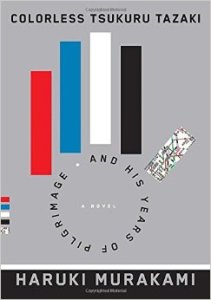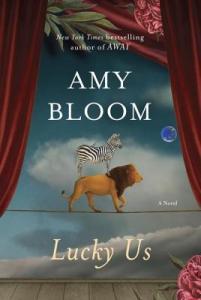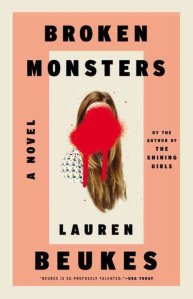Haruki Murakami is one of my favorite contemporary authors, so when Colorless Tsukuru came out in the U.S. in August, and I picked up a copy pretty quickly. However, I didn’t get a chance to start reading it until the beginning of the new year because I was working on a ghost writing project of my own.
Title: Colorless Tsukuru Tazaki and His Years of Pilgrimage
Author: Haruki Murakami
Year: 2013 (Japan) / 2014 (U.S.)
Genre: Fiction
Setting: Nagoya and Tokyo, Japan
Characters: Tsukuru (narrator), Aka (“Red,” the smartest), Ao (“Blue,” the rugby player), Shiro (“White,” the pianist), Kuro (“Black,” Shiro’s best friend), Sara (girlfriend), Haida (swimmer)
Plot: In high school, Tsukuru, Aka, Ao, Shiro, and Kuro, were inseperable best friends, but Tsukuru is the only one who leaves to go to college in Tokyo. He becomes a railway engineer, designing railway stations, and one day, he receives a call and is told to never talk to his four friends again. He reels from depression and struggles with ever trusting or letting anyone in again, especially after befriending Haida, a swimmer, only to lose him mysteriously as well. Sixteen years after he loses touch with his friends, Tsukuru meets Sara, who tells him he must resolve the issues in his past, and he finally reconnects with his friends and discovers why he was cut off and whether he can trust anyone again.
Verdict: I missed the elements of magical realism that 1Q84, The Wind-Up Bird Chronicle, and Kafka on the Shore incorporate, though the character Haida does offer a glimpse of that mystery, which is never really resolved. Murakami also scaled back on the historical elements that he often interweaves, choosing only to mention some of the student protests in the 60s. However, I connected with Tsukuru’s struggle to trust, his fear of being abandoned, his tendency to isolate and disconnect. The chapters were well-paced, and I enjoyed my time in each era of Tsukuru’s life. This wouldn’t be my first recommendation if I wanted someone to read Murakami, but it’s more digestible and accessible than a tome life 1Q84 and was a good book to start out the year.


 This was Riot Read #3 (September), though I read October’s first. The inside flap promised me an interesting story of America in the 1940s and of two sisters with madcap lives… or at least that was what I expected going in. I also hoped the lion and zebra on the tight rope would figure in.
This was Riot Read #3 (September), though I read October’s first. The inside flap promised me an interesting story of America in the 1940s and of two sisters with madcap lives… or at least that was what I expected going in. I also hoped the lion and zebra on the tight rope would figure in. I subscribe to
I subscribe to 